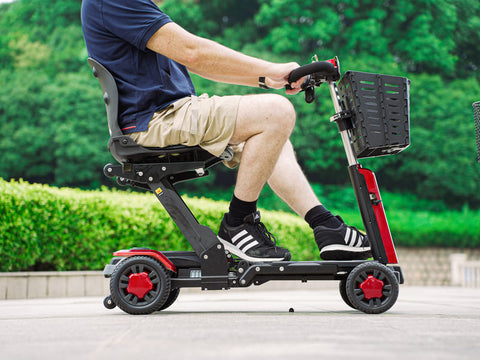Mobility scooters can have a tremendous impact on people’s lives by giving them independence and enhancing their sense of wellbeing. This article outlines the key components and latest technology behind mobility scooters to provide insights into how they work.
The battery
The battery is the core element of the mobility scooter as it provides all the power output. The battery is usually either lead-acid or lithium-ion. Lithium-ion batteries are lighter, offer longer life and charge faster. All mobility scooter batteries are rechargeable and typically last several hours per charge, which can support journeys over considerable distance. The performance and lifespan of the scooter depend hugely on the quality of the battery, and so it is always worth choosing one with a robust battery to avoid frequent replacements.
The electric motor
The motor ensures that the scooter is propelled forward. Electric motors are powered by the energy stored in the battery. There are various electric motors to choose from in a mobility scooter, but the majority are brushless DC because of their efficiency and longevity.
The power of the motor varies per scooter model to suit differing usages. Scooters intended for pavement only use in urban environments tend to have smaller motors, while larger models offer more powerful motors for outdoor use and uneven terrains.
The braking system
Arguably the most important safety feature of mobility scooters is the braking system, with electromagnetic brakes typically coming as standard. These automatically engage when the scooter stops or when the throttle is released. Reliability is very high, minimising the risk of accidents. More advanced models also offer manual brake levers for added control. For safety reasons, it is important to ensure a scooter’s braking system is responsive and well-maintained.
Controls and Steering
Mobility scooters are packed with intuitive controls offering simplicity of use. Joysticks or handlebars are common, which, together with the throttle controls, allow the user to control the speed and direction of the scooter. Other features such as the lights, indicators and horn for road safety are also usually found via buttons on the handlebars.
More advanced scooter models offer user-friendly LCD displays, which provide drivers with key information such as speed, battery life and distance travelled.
Suspension and comfort
Comfort is important for any long-term mobility scooter solution. High-end models are equipped with suspension systems to absorb shocks from uneven terrain, presenting a smoother and more comfortable ride. Like on a car, the suspension system operates by distributing the weight evenly across the device, allowing it to handle bumps and rough surfaces with ease.
Seating options offer ergonomic support with adjustable armrests and backrests to meet the specific needs of users.
Understanding how mobility scooters work helps to support an informed decision-making process ahead of purchasing one. Due attention should be paid to the battery type, the power of the motor, the braking system, the controls and steering, as well as the range of comfort features available. What matters most is finding a model appropriate to your needs and budget, whether it is an indoor option for navigating tight spaces or an outdoor mobility scooter built for rough terrain.







